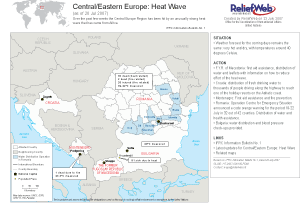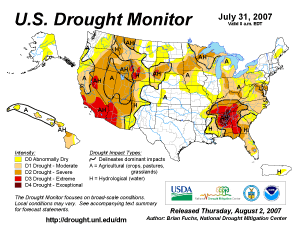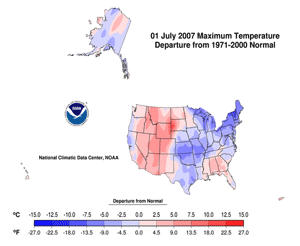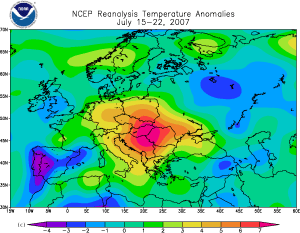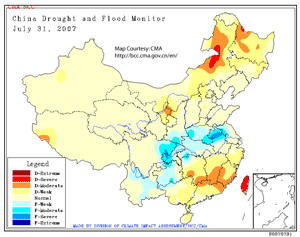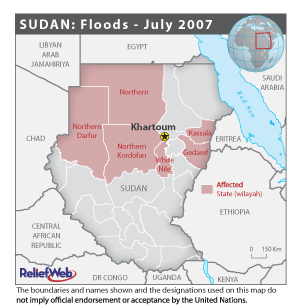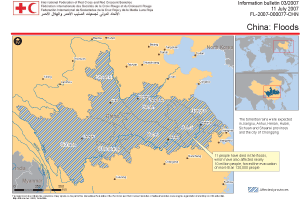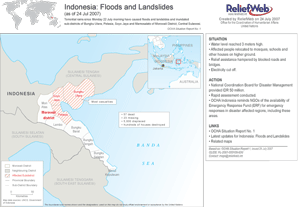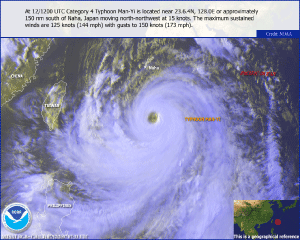
Global Hazards and Significant Events
July 2007
Extremely hot conditions affected much of central and southeastern Europe during mid-to late July. Additional information can be found below.

Across the United States, extreme drought conditions persisted in areas of Wyoming, Nebraska, South Dakota, Nevada and throughout much of the Desert Southwest and the Southeast region. Exceptional drought was present in Alabama and parts of southern Tennessee. On July 31, 63% of the western U.S. was in moderate to exceptional drought, 80% in the Southeast, and 46% for the contiguous U.S., according to the Federal U.S. Drought Monitor.
A heat wave affected areas across the western contiguous U.S. during the first week of July. Temperatures exceeded 40°C (104°F) across the region, breaking maximum temperature records in several cities. These dry and hot conditions throughout much of the western U.S. enhanced wildfire potential, with numerous large fires across the Northwest. For more information on July's wildfires, please visit the July 2007 Wildfire page.
Central and southeastern Europe suffered from a heat wave during mid to late July which brought temperatures in many areas well over 40°C (104°F). The excessive heat and dry conditions claimed hundreds of lives and promoted forest fires that burned thousands of acres in Italy, Bulgaria, Macedonia, and Greece, and killed 4 people in southern Italy. On July 19, 115 fires were reported in a 24-hr period in Greece alone (Associated Press/AFP). As a result of the heat wave, Romania reported 30 fatalities and Hungary reported 500 fatalities (AFP). The excessive heat was also responsible for water shortages, power cuts and agricultural damages. In Romania, agricultural losses are estimated to be about $2 billion (Associated Press).
While central and southeast China suffered from floods, north and northeast China suffered from the worst drought in two decades (AFP). According to reports, the areas affected received 50%-90% less rainfall than expected during July (BBC News). The persistent drought generated a water crisis for 1.2 million people and affected 10.9 million hectares of agricultural land (Xinhua).

Heavy rainfall during July caused the rivers to overflow and triggered flash floods across northern parts of Sudan forcing hundreds of families to evacuate the area. The flood waters destroyed approximately 18,000 homes and were responsible for injuring 100 people and killing more than 50 others. According to residents, the event is Sudan's worst flooding in living memory (BBC News/Reuters).
In the south central United States, heavy rainfall, which began in mid June, continued into early July prompting flash floods that destroyed hundreds of homes across Kansas, Missouri, Texas, and Oklahoma. The floods, according to reports, caused about $200,000 in damages and were responsible for at least 17 fatalities (Associated Press/BBC News). Numerous daily rainfall records were set.
Heavy rain, which began in June 2007 across parts of China, continued in July. During the first week of July, torrential rainfall generated devastating floods and landslides which affected about 500,000 people in Jiangsu, Anhui, Henan, Hubei, Sichuan, Shaanxi, and Chongqing provinces. About 94 fatalities were reported with 25 others missing. The floods and landslides also destroyed about 49,000 homes and damaged approximately 240,000. During July 15-18, severe storms pounded central and eastern parts of China, killing at least 37 people mainly due to mudslides and lightning strikes. In the city of Chongqing, an intense thunderstorm produced heavy rains which triggered flooding that affected about 113,000 people and destroyed about 10,000 homes. From July 16-17, Chongqing reportedly received 227 mm (9 inches) of rain in a 24-hr period. This amount of rain broke the previous 24-hour record of 206 mm (8 inches) that was set on July 21, 1996 and thus became the largest rainfall in a 24-hr period since records began in 1892. Economic losses have been estimated to exceed $500 million (Associated Press).
During July, heavy rain fell across eastern and northeastern India producing floodings that affected more than a million people and led to approximately 150 fatalities (AFP).
Heavy monsoon-related rainfall prompted landslides that killed at least 26 people in western Nepal on July 12. Six people remained missing (AFP). Heavy rains continued into late July, leaving thousands of people homeless and destroying crops (Reuters).
In northwestern Pakistan, heavy rain fell during July 20-22 which triggered flooding that destroyed over 20 homes and killed 80 people (BBC News). Meanwhile in Bangladesh, heavy rains prompted floods that inundated north and central areas of the country. Approximately one million people were affected and 16 people were killed (AFP).
In Indonesia, heavy rain fell during July 22-25 prompting floods and landslides that affected about 5,000 people and was responsible for 107 fatalities (OCHA/AFP).
Heavy rainfall during July 21-29 brought widespread flooding across parts of the United Kingdom producing the worst flooding since 1947. The heavy rains resulted in the swelling of rivers, forcing thousands of people to evacuate the area. Approximately 48,000 homes in the counties of Gloucestershire and Herefordshire were left without electricity and about 150,000 homes had water supplies cut off since the power station and a Tewkesbury water treatment plant were flooded and became inoperable. According to reports, the Severn River reached its highest level since 1947 (BBC News/Associated Press). On July 26, the UK Met Office reported that, for England and Wales, May to July 2007 was 201 mm (8 inches) above the 1971-2000 mean and ranked as the wettest May-July since records began in 1766. The previous record was set in 1789. A complete summary is available courtesy of the UK Met Office.
Floods triggered by incessant rains affected Burkina Faso's western Bama region during July 28-30. The heavy rains, described as the worst in 16 years, affected thousands of people and destroyed hundreds of homes. According to reports, 165 mm (6.5 inches) of rain fell during the 28th-29th (AFP).

Across eastern China, severe thunderstorms spawned a weak tornado with wind speeds of up to 100 km/hr (54 knots or 62 mph) that affected three villages in the Anhui province on July 10. The tornado destroyed more than 100 homes and was responsible for injuring 146 people and killing 14 others (Reuters).

Typhoon Man-Yi developed as a depression in the western Pacific Ocean on the 8th, reaching typhoon intensity by the 10th. Early morning on the 13th, Man-Yi made landfall in the southern island of Okinawa with maximum sustained winds near 100 mph (160 km/hr or 86 knots). The strong winds left more than 60,000 people without power (BBC News). On the 14th, Man-Yi made landfall on the southern part of the islands of Kyushu and Shikoku and immediately weakened as it tracked toward the northeast. Typhoon Man-Yi was responsible for 5 fatalities and was reportedly the most powerful storm to hit Japan in July since records began in 1951 (AFP).
For 2006/2007 basin tropical cyclone statistics, please refer to the following:
Australian Basin
North Indian Ocean Basin
Western North Pacific Basin
South Pacific Basin
South Indian Ocean Basin
Northeast Pacific Ocean Basin
Atlantic Basin

No reports of significant extratropical cyclones were received during July 2007.

Cold weather in Argentina resulted in snowfall in its capital city, Buenos Aires, on July 9. It was the first major snowfall since 1918 (Associated Press).
 NOAA's National Centers for Environmental Information
NOAA's National Centers for Environmental Information
